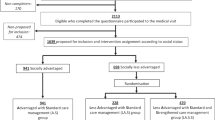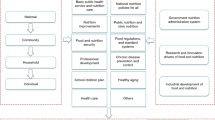Abstract
Overweight and obesity are major world global health challenges of the 21st century. Mexico is not an exception. Approximately 70% of the adult Mexican population has an excessive body weight. The prevalence of obesity and overweight in Mexican school children aged 5–11 is also high: one child in four is overweight. In light of the seriousness of the situation, the solutions for this problem are based on modification of the environments and change of individual habits and behaviors related to nutrition and physical activity. As a result, the Mexican government, public sector and academy established three common goals and 10 priority objectives that are expressed in the National Agreement for Nutritional Health—Strategy to Control Overweight and Obesity. The obesity problem requires interventions and policies that reside outside of the health sector domain, key aspects of this public health policy was agreement among all stakeholders on cross-cutting actions. The best examples of National Agreement's inter-sectorial action implementation is in the school setting and Code of ‘Self Regulation’ on Advertising of Food and Non-Alcoholic Beverages to Children introduced by the food and beverage industry. The ultimate goal of this national policy is to provide the strategic plan for healthy weight and better health, by promoting healthy lifestyles focused on correct diet and physical activity in all life stages, from pregnancy and early childhood and on into adulthood by a multi stakeholder approach. Although there have been great achievements in some areas of implementation, there are still challenges to confront.
This is a preview of subscription content, access via your institution
Access options
Subscribe to this journal
We are sorry, but there is no personal subscription option available for your country.
Buy this article
- Purchase on Springer Link
- Instant access to full article PDF
Prices may be subject to local taxes which are calculated during checkout

Similar content being viewed by others
Change history
10 December 2013
A Correction to this paper has been published: https://doi.org/10.1038/ijo.2013.186
References
Organization for Economic Co-Operation and Development. Obesity Update 2012 (cited 27 August 2012). Available from: http://www.oecd.org/els/healthpoliciesanddata/49716427.pdf.
Olaiz-Fernandez G, Rivera-Dommarco J, Shamah-Levy T, Rojas R, Villapando-Hernandez S, Hernandez-Avila M et al. Encuesta Nacional de Salud y Nutrición 2006. Instituto Nacional de Salud Publica: Cuernavaca, Mexico, 2006.
Secretaria de Salud. Bases para una Política de Estado para la Prevención de la Obesidad. Instituto Nacional de Salud Pública: Cuernavaca, Mexico, 2009.
Rivera–Dommarco J, Shamah T, Villapando Hernandez S, Gonzalez de Cossio T, Hernandez Prado B, Sepulveda J . Encuesta Nacional de Nutrición 1999. Estado nutricio de niños y mujeres en Mexico. Instituto Nacional de Salud Publica: Cuernavaca, Mexico, 2001. Available from: http://www.nutricionenmexico.com/encuestas/ENN-99.pdf.
Secretaría de Salud, Dirección General de Promoción de la Salud. Acuerdo Nacional para la Salud Alimentaria: Estrategia contra el sobrepeso y la obesidad. Mexico. Dirección General de Promoción de la Salud, 2nd Edition, 2010.
Rivera–Dommarco J, Shamah T, Villapando S, Cuevas L, Mundo V, Morales-Rual C . El estado nutricional de la población de México: cambios en la magnitud, distribución y tendencias de la mala nutrición de 1988 a 2006. Salud Pública, Nutrición y Pobreza: Política pública basada en evidencia, Mexico, Banco Mundial-SEDESOL, 2008, pp 1–22.
Instituto Nacional de Salud Pública. Encuesta Nacional de Salud de Escolares. Mexico, 2008 (updated 18 July 2012; cited 28 August 2012). Available from: http://www.insp.mx/images/stories/Produccion/pdf/101202_ense.pdf.
Secretaría de Educación Pública, Secretaría de Salud. Lineamientos Generales para el expendio o distribución de alimentos y bebidas en los establecimientos del consumo escolar de los planteles de educación básica, Mexico, 2010 (cited 31 August 2012). Available from: http://promocion.salud.gob.mx/dgps/descargas1/programas/escuela_salud/Lineamientos_alimentacion_escuelas.pdf.
Consejo Nacional de Autorregulación y Ética Publicitaria. Código de Autorregulación de Publicidad de Alimentos y Bebidas no alcohólicas dirigida al público infantil. Mexico, 2008 (cited 2 September 2012). Available from: http://www.promocion.salud.gob.mx/dgps/descargas1/programas/codigo_pabi.pdf.
Acknowledgements
Publication was supported in part by the Government of Aruba, the Obetech Obesity Research Center, the Pan American Health Organization and the Pan American Health and Education Foundation. This paper is derived from the workshop ‘Education for childhood obesity prevention: A life-course approach’, co-organized by the Panamerican Health Organization (PAHO) and the Panamerican Health and Education Foundation (PAHEF), and held on 14 June 2012 in Aruba, as part of the II Pan-American Conference on Childhood Obesity (http://www.paco.aw/).
Author information
Authors and Affiliations
Corresponding author
Ethics declarations
Competing interests
The authors declare no conflict of interest.
Rights and permissions
About this article
Cite this article
Latnovic, L., Rodriguez Cabrera, L. Public health strategy against overweight and obesity in Mexico's National Agreement for Nutritional Health. Int J Obes Supp 3 (Suppl 1), S12–S14 (2013). https://doi.org/10.1038/ijosup.2013.5
Published:
Issue Date:
DOI: https://doi.org/10.1038/ijosup.2013.5
Keywords
This article is cited by
-
The water footprint and nutritional implications of diet change in Mexico: a principal component analysis
European Journal of Nutrition (2022)



